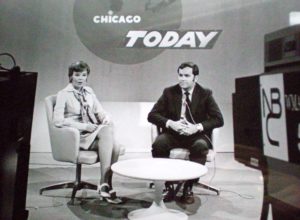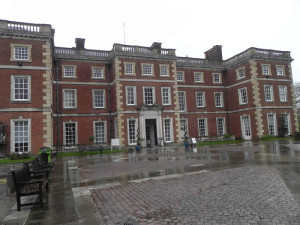AUTHOR OF THE YEAR AWARD AT US NAVAL ACADEMY 
Recognizing what it called “his significant literary contributions to the history of World War Two”, the U.S. Naval Institute awarded Jerome M. O’Connor its “Author of the Year” in 2000. In accepting the award at a U.S. Naval Academy banquet attended by its 2001 graduating class, O’Connor spoke about the duty, honor and sacrifice of the soldiers, sailors and airmen of the Second World War, and the obligation to honor their sacrifice.
 A passion for realism and authenticity has been the principle focus for most of Jerome O’Connor’s journalistic production. In 1965, his first feature story described the disrepair and neglect of one of Chicago’s largest and most important outdoorsculptural works, Lorado Taft’s Fountain of Time on the famous Midway, the site of the 1893 World’s Columbian Exposition. The four page color feature in the Chicago Tribune Sunday Magazine caused a public outcry and resulted in funds to preserve the work.
A passion for realism and authenticity has been the principle focus for most of Jerome O’Connor’s journalistic production. In 1965, his first feature story described the disrepair and neglect of one of Chicago’s largest and most important outdoorsculptural works, Lorado Taft’s Fountain of Time on the famous Midway, the site of the 1893 World’s Columbian Exposition. The four page color feature in the Chicago Tribune Sunday Magazine caused a public outcry and resulted in funds to preserve the work.
In 1973, also for the Chicago Tribune, the difficulties facing the Republic of Ireland as it considered joining the then Common Market, appeared as the lead article in the Tribune Sunday Perspective section. Another article reported from the barricades in Belfast, as pitched battles were waged between Protestant and Catholic extremists.
To get close to both the action and the problems, in August 1972 O’Connor donned British camouflage and a flak jacket, and joined a Midnight patrol of the 40th Royal Marine Commando enforcing a dusk to dawn curfew in the “no go” areas in troubled Belfast. On this patrol O’Connor learned that the sun-tanned Commandos had been trained by U.S. Marines, and supplied with night vision scopes by the U.S. military. Reporting this development resulted in an investigation led by Sen. Edward Kennedy.
THESE BOOK CHAPTER SUMMARIES DESCRIBE THE OVERLOOKED BUT VITAL PEOPLE, PLACES AND EVENTS OF WW II, MOST DISCLOSED FOR THE FIRST TIME.

“Unveiling the Churchill War Rooms“ in the Chicago Tribune Sunday Magazine, was the first to reveal the existence of the Churchill Cabinet War Rooms across from St. James Park in central London. Disclosing the intact underground enclave and its unchanged appearance contributed to its 1984 opening as a museum, now one of London’s most visited. In 1978, the author saw part of the fully furnished Cabinet War Rooms with a one-cell flashlight, 7 years before it opened to the public. (wartime photo of CWR showing blast wall at base)
 “Secret at Bletchley Park” in Naval History magazine, was the first major feature to describe the then neglected (photo) and unknown locale where Nazi Germany’s most important secret, the inner workings of the Enigma cypher were revealed. Along with the Manhattan Project, the breaking of the Enigma machine was the war’s major secret. The article resulted from the author’s chance meeting with a one-time “secret lady,” one of 12,000 staffers at Bletchley Park. Known as ULTRA, the top-secret breaking of the Nazi’s most important means of secret communication revealed German intentions often before even Hitler was informed. The 12,000 unheralded codebreakers helped to end the war in 1945, instead of 1947. Other versions appeared in World War Two, British Heritage, and Finest Hour magazines.
“Secret at Bletchley Park” in Naval History magazine, was the first major feature to describe the then neglected (photo) and unknown locale where Nazi Germany’s most important secret, the inner workings of the Enigma cypher were revealed. Along with the Manhattan Project, the breaking of the Enigma machine was the war’s major secret. The article resulted from the author’s chance meeting with a one-time “secret lady,” one of 12,000 staffers at Bletchley Park. Known as ULTRA, the top-secret breaking of the Nazi’s most important means of secret communication revealed German intentions often before even Hitler was informed. The 12,000 unheralded codebreakers helped to end the war in 1945, instead of 1947. Other versions appeared in World War Two, British Heritage, and Finest Hour magazines.

“Inside the Gray Wolves Den “ in Naval History magazine, revealed the still existing, difficult to locate, but now partially opened former German U boat bases in France. For this work, the U.S. Naval Institute named O’Connor its “Author of the Year.” The extraordinary engineering and operational triumph made the five bases invulnerable to Allied air attacks. Remaining fully operational until VE Day, decades later the unchanged and intact U-boat bases remain as the largest and most complete vestige of the war. The U-boats brought Germany the closest they would come to winning the war.

“The Wolves Elegant Lair” from Naval History, describes the author’s visit – the first ever – to the intact, undamaged Lorient, France headquarters of U-boat commander, Admiral Karl Donitz. In the chateau’s elegant interior, the wolf-pack architect planned the U-boat missions that almost defeated Britain early in World War Two. Rare author photos reveal an unchanged interior and the same room where Admiral Donitz interviewed returning U-boat captains, and evaluated the detailed Atlantic charts. See the purpose-built (photo) attached operational bunker in the only known images of U-boat headquarters. The author was the first journalist allowed to enter the intact headquarters of the U-Boat mastermind, which is not open to the public.
Alan Turing – Enigma,” from British Heritage magazine, recounts the sometimes bizarre and little known saga of one of the 20th Century’s most original and most neglected intellects. Combining the almost requisite traits of absolute genius and near certifiable madman, Allan Turing cracked the “unbreakable” Nazi code. But years earlier in 1936, Turing also theorized an automatic problem-solving machine that defined in all ways except by name, the operating system of a modern digital computer. Turing is considered one of the father’s of modern computing, but his war-winning contributions remain little-recognized.

“THE GHOST SHIPS OF TASK FORCE FOURTEEN ” in Proceedings magazine (US Naval Institute), continues as the only disclosure of a top-secret pre-war British troop convoy to Singapore. Violating the strict US Neutrality Act, President Roosevelt approved Prime Minister Churchill’s near desperate request to transport British troops aboard America’s three most modern and important ocean-liners (Photo: USS West Point -SS America): The ultimate fate for thousands of the Tommies carried on the three ships was starvation and death in cruel captivity after the fall of “fortress” Singapore. Decades later the voyage remains ignored in every history about World War Two. Knowing that an undefeated Britain was America’s first and only line of defense, read why FDR broke the Neutrality Act, risking impeachment by the US Congress, and approved a mission that began one month before the Pearl Harbor attack.

“ROOSEVELT’S UNDECLARED WAR,” the February 2004 cover feature in Naval History magazine. From research at the National Archives, the author proved by securing the actual copies of the pre- Pearl Harbor “shoot on sight” orders to the Atlantic Fleet, that the President’s first duty is to protect and defend the Constitution. This was as true in 1941 as in today’s world-wide war on terror. FDR had no regrets in precipitating war with Nazi Germany if, by avoiding a high-seas confrontation, it would have meant Britain’s defeat. But the 1941 secret orders also suggest that an early American entry into World War Two may have averted the Pearl Harbor attack.

“SOUTHWICK HOUSE – Where D Day Began,” explores with rare photos the unchanged interior of the stately home near Portsmouth where, under desperate weather conditions, General Dwight D. Eisenhower made the decision, “let’s go,” launching the Normandy invasion that changed history and made Allied victory possible in World War Two. It’s Another place forgotten by history that exists now as it did then.

QUEEN MARY 2 LECTURE SERIES introduced thousands of passengers on four trans-Atlantic voyages to the little known aspects of 20th Century history based on features from this site. An average of 375 passengers attended each of 15 Power – point lectures aboard ship. 
INSIDE FRANK GEHRY’S BEDUOIN TENT reviews the dramatic Frank Gehry designed New World Music Center in Miami Beach. The visually and acoustically appealing new music venue is in the heart of the vibrant South Beach entertainment district, yet artfully blends into its Art Deco surroundings. Unlike Gehry’s other works, especially the Pritzker Pavilion in Chicago’s Millennium Park, the New World Music Center takes an uncharacteristically sober approach to successfully produce a work that integrates into its 1930’s surroundings.
SECRET SERVICES reveals the last major secret of World War Two, the WESTERN APPROACHES COMMAND CENTRE in Liverpool. Rare original images from inside an underground complex with 50,000 sq. ft. of bomb-proof space. The massive concrete-encased space controlled all convoys originating in North America. Overlooked by historians and unknown to history.
TRENT PARK TATTLETALES The London mansion where 59 Nazi officers, mostly generals, were incarcerated after capture or surrender. They had the run of the house and expansive grounds, and could even wear uniforms and enjoy fine dining with beverages. With increasing confidence they started talking to each other about battles won or lost and strategies that succeeded or failed. What they didn’t know is that every word was recorded from microphones hidden throughout the house. Listeners proficient in German were hidden in the basement recording the conversations, with the most actionable results sent to the battlefield. O’Connor was the last visitor allowed to photograph the basement and main rooms before closing in 2018 for conversion into a condominium. The Hidden Places of World War II includes exclusive photos of the interior before its closure.
Jerome M. O’Connor, a Chicago area resident, certified Chicago tour guide, and college continuing education instructor, deeply researches and lectures about the little-known, overlooked, or under-reported people, places and great events of modern history. To qualify, all locations must exist and have contributed to the history of our time. Contact me here.


